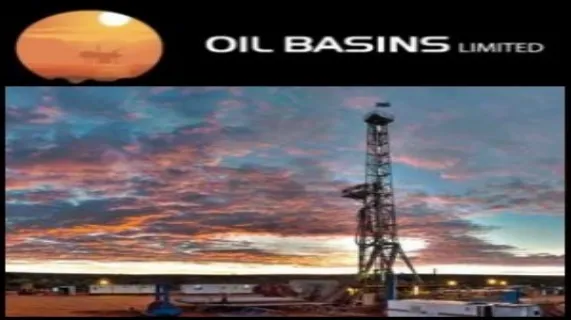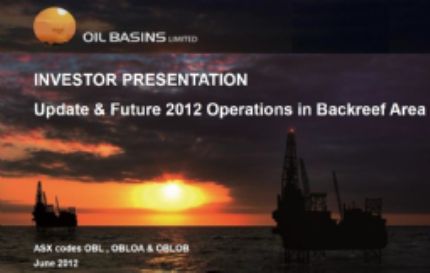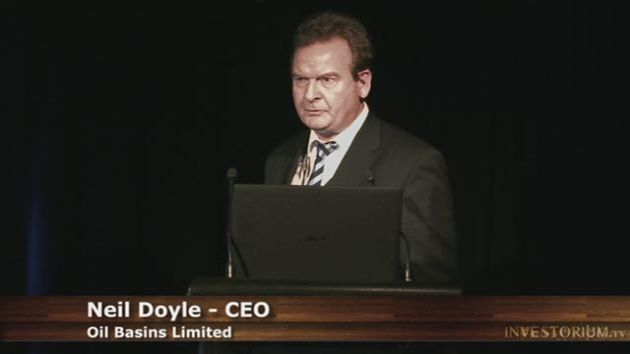
Oil Basins Limited (ASX:OBL) Signed Rig Contract For Backreef-1 Drilling
Melbourne, Sep 6, 2010 AEST (ABN Newswire) - Oil Basins Limited ( ASX:OBL) wishes to make the following ASX Announcement, so as to keep the market fully informed.
ASX:OBL) wishes to make the following ASX Announcement, so as to keep the market fully informed.
Further to the Non-Renounceable Rights Issue Offer (Prospectus) fully underwritten by Patersons Securities Limited to raise circa A$5.262 million before costs and dated 17 August 2010, which is due to close on 13 September 2010, the Company is pleased to advise the ASX that on Friday 3 September, 2010 - the Company, as Designated Operator, Backreef Area has significantly advanced its preparations for the proposed drilling operations, whereby:
- The Company has conditionally committed to the Drilling of Backreef-1 to 1,600m (OBL earning 90% by funding 100% of all costs) - conditional upon the Rights Issue raising A$5.262 million.
- Entered into a Letter of Intent to Contract a Petroleum Drilling Rig for the drilling of Backreef-1, subject to the Rights Issue raising A$5.262 million and the Drilling Rig being cleared for use in WA by the WA Department of Mines and Petroleum (DMP); and
- Formally lodged an Application for Approval to Drill Backreef-1 (and supporting information) with the WA Department of Mines and Petroleum and stakeholders.
The timing and application of funds for this exploration well is consistent with the information in the Prospectus -
Costs - the gross dry hole cost of drilling the Backreef-1 exploration well is estimated at circa A$1.9 million, the gross successful well cost is estimated at circa A$2.6 million (assuming a possible contingent deepening).
Drilling Rig - The Backreef-1 exploration well will be drilled by Hunt Energy & Minerals Co. Rig 3 which is rated to drill to 2,300m. The rig is presently in service in the Amadeus Basin, Central Australia.
Time & Spud Date - the drilling time is estimated at around 14 days to drill, evaluate and complete and subject to all relevant stakeholder approvals, Backreef-1 will spud in early October 2010.
1.0 Backreef Area and Backreef-1 Well
The Backreef Area comprises EP 129 Remainder (R)2 (part thereof), R3 & Licence (L)6, (part thereof).
1.1 Backreef-1 Wildcat Well Licence 6
Backreef-1 is a high-risk exploration -Wildcat- well with prognosed well depth estimated 1600m.
1.2 Designated Operator : Oil Basins Limited - earning 90% (by funding 100%)
Following the completion of the Backreef-1 well, the ownership interests in Backreef Area will be as follows:
- Oil Basins Limited or Nominee) (Notes 1,2,4): 60% (Designated Operator)
- OBL Backreef No.5 Pty Ltd (Notes 1, 2): 5%
- OBL Backreef No.10 Pty Ltd (Notes 1, 2): 10%
- Canning Basin Oil Limited (Notes 1, 2) 15%
- Backreef Oil Pty Limited ("Backreef") (Notes 1, 2, 4): 10% (Contract Well Operator)
- Titleholder (Note 3): Nil% (holds back-in rights 30%)
Note 1: Columbus Energy Ltd ( CVE:CEL) (
CVE:CEL) ( PINK:CELYF) owns a 2% ORRI payable by Backreef Area Joint Venture Partners (JVPs)
PINK:CELYF) owns a 2% ORRI payable by Backreef Area Joint Venture Partners (JVPs)
Note 2: European Gas Limited ( ASX:EPG) (
ASX:EPG) ( PINK:EUPGF) owns a 3% ORRI payable by Backreef Area JVP's and Budside Pty Ltd owns a 1% ORRI over EP129, but excluding L6 & L8 - these royalties are payable by Backreef Area JVP's.
PINK:EUPGF) owns a 3% ORRI payable by Backreef Area JVP's and Budside Pty Ltd owns a 1% ORRI over EP129, but excluding L6 & L8 - these royalties are payable by Backreef Area JVP's.
Note 3: EP129 and L6 Titleholder is Buru Energy Limited ( ASX:BRU) (
ASX:BRU) ( PINK:BRNGF) and holds one-off back-in rights for 30% by paying OBL 90% of well costs within 90 days of drilling Backreef-1.
PINK:BRNGF) and holds one-off back-in rights for 30% by paying OBL 90% of well costs within 90 days of drilling Backreef-1.
Note 4: OBL is carrying Backreef Oil Pty Limiited as to 10% thereby increasing its Group holding to 90%
1.3 Drilling Rig
OBL is planning to formally engage Hunt Energy & Minerals Co. Drilling Rig 3 which is rated to drill to 2,300m.
2.0 Exploration Prognosis
2.1 Reason for Drilling
The target in Backreef-1 is Devonian-aged sands in the Clanmeyer Formation deposited in a debris flow off the reef edge southwest of Harold-1. Based on acoustic impedance characteristics, these sands are interpreted to have preserved porosity. The section is likely to be self-sourcing and sealed by shales of the Clanmeyer Formation. The interpreted prospective section is centred on 1,500 metres.
2.2 Location
The location is 260 km east of Broome and 8.5 km north northeast of the Blina Oilfield facility.
From Derby, head east 70 km on the Gibb River Road then turn right on the road to the Blina Oilfield. At the Blina Oilfield, turn left to the wellsite.
The well is located in Production Licence L 6 with the following coordinates:
- Location: GDA94
- East: 665786
- North: 8052370.2
- Lat: 17 degree 36' 32.99"
- Long: 124 degree 33' 44.95"
The well site is 6.4 km east-northeast of the Blina oilfield on shot point of existing SP522 Seismic Line BV93-17 (shot in 1993 by Bow Valley).
3.0 Regional Geology
L6 and EP 129 are located in the northern Canning Basin and includes part of the Lennard Shelf and part of the Fitzroy Trough. The Lennard Shelf has a relatively shallow basement compared to the Fitzroy Trough, and the sediments thicken westward to its fault-controlled margin. The Fitzroy Trough is fault-bounded on the north side by the Beagle Bay and Pinnacle Fault systems and on the south by the Fenton Fault system.
The oldest known Phanerozoic strata in the Canning Basin are Ordovician clastics and carbonates, which overlie a Precambrian igneous and metamorphic basement. After a long period of emergence, movement along the Beagle Bay-Pinnacle and Fenton Faults systems during the Devonian initiated the Fitzroy Trough and separated the Lennard Shelf. On the block-faulted shelf, clear water deposition with reef complexes took place during the Middle and Late Devonian. Overlying these are the shallow marine carbonates and siliclastics of the Late Devonian-Early Carboniferous Fairfield Group, comprising the Gumhole, Yellow Drum and Laurel Formations.
The predominantly sandy Anderson Formation was deposited next, followed again by erosion at least on the Lennard Shelf. Above this unconformity, the sand-dominated Late Carboniferous Grant Group was deposited in a continental environment. Marine Permian and Triassic clastic sediments unconformably overlie the Grant Group. In the middle Triassic, major right lateral movements along the bounding faults of the Fitzroy Trough caused further uplift and structuring. Since then the Lennard Shelf has remained elevated and has been eroded.
4.0 Primary Objective Summary
The target at Backreef-1 is an interpreted debris flow-deposited sand body in Clanmeyer sequence - refer to ASX Announcement dated 8 December 2009.
4.1 Backreef Prospect
Givetian to Famennian (Middle and Late Devonian) platform reef complexes extend over 350 km along the northern margin of the onshore Canning Basin, adjoining Precambrian rocks of the King Leopold Orogen and Kimberley Basin to the north (Playford, 1984). Siliciclastic sediments including cobble to boulder conglomerates and sandstones interfinger with and cut through these reefal carbonates in platform, marginal slope and basin settings, forming sometimes complex sequences of mixed carbonate and siliciclastic deposition. Depocentres were active at different times along the Lennard Shelf and Fitzroy Graben, with pronounced siliciclastic pulses occurring through the late Frasnian and Famennian. The provenance of these coarse siliciclastics was the Precambrian Kimberley Basin to the northeast and the King Leopold Orogen, with some contribution from the reefal complexes themselves.
Reef growth continued during siliciclastic deposition as conglomerates and sandstones commonly grade laterally into platform-facies limestones. Platform-carbonates are intimately interbedded with the coarse siliciclastics marking periods of decreased terrigenous influx.
The coarse siliciclastics were deposited as submarine fans and slope aprons that interfinger with deep marine marginal-slope carbonates. A terrigenous, silty marginal-slope and basin facies, the Virgin Hills Formation, coincides with the height of conglomerate deposition in the late Frasnian and early Famennian. This sequence was penetrated at the base of the Blina-1 well where significant gas shows were observed in drilling mud.
At Blina-1, the Virgin Hills Formation is overlain by platform and overlying carbonate reefal buildups represented by Famennian Windjana and overlying Nullara limestones. Basinward, contemporaneous deposition of calcareous marine claystones belonging to the Clanmeyer Formation margining the limestones buildups, occurred in the Fitzroy Graben south of Blina Reef Trend and to the north in the Kimberley Downs Embayment on the faulted southern margin of the Lennard Shelf. More proximal shallow water shelf clastics and carbonate deposits of the Luluigui Formation were also deposited at this time.
The Backreef Prospect is a large stratigraphic trap defined by a package of seismic (acoustic impedance) reflectors in the Clanmeyer Formation. The prospect is situated in the Kimberley Downs Embayment on the faulted southern margin of the Lennard Shelf. The play involves submarine fan sandstones deposited with marine calcareous claystones in the Upper Devonian (Famennian) Clanmeyer Formation. The sandstones are sealed intra-formationally and pinch out up-dip towards reefal complexes on the basin margin, dipping to the south and southeast. This is a new reservoir play type in the Clanmeyer Formation that has not been tested previously in the Canning Basin.
The presence of submarine fans sandstones in the Clanmeyer Formation in the Kimberley Downs Embayment is predicted by the presence of low impedance sequences on seismic. Their presence was first indicated on an acoustic impedance seismic inversion conducted on seismic line BV93-17 by Robertson Research. Recent inversion conducted on the same line and additional line H84-22 in 2008 by Dayboro Geophysical also indicate the presence of low impedance anomalies interpreted as representing a submarine fan sandstone complex. These sandstones are interpreted to have been deposited during a Mid- to Late Famennian lowstand period in erosional channels as seen on seismic inversion sections.
The trap is either self-sourced by organic-rich sequences in the Clanmeyer Formation itself, or by underlying Upper Devonian (Frasnian) marine, organic-rich shales of the Gogo Formation. The Blina oil accumulation is thought to have been sourced from Frasnian Gogo Formation shales (Playford, 1984 and Moors et al., 1984). The importance of these basinal source facies is constrained by a lack of data. Maturation modelling by Brown et al. (1984) indicates the Upper Devonian section is overmature for oil generation in the centre of the Fitzroy Graben and oil generative on the margins of the trough.
Migration from deeper source rocks into shallower reservoirs on the Lennard Shelf are controlled by fracture systems associated with transfer faults connecting the Lennard Shelf to the deeper FitzroyTrough. A normal fault that has subsequently undergone a degree of inversion underlies the Backreef Prospect, cutting upward through source rocks of the Gogo Formation into the Clanmeyer Formation. The fault is associated with a zone of seismic disruption in the Clanmeyer which could be interpreted as a gas chimney, a possible Direct Hydrocarbon Indicator (DHI).
4.2 Independent Expert Geological Reports
During early 2009, OBL commissioned an Independent Expert Geologist Report of the Hydrocarbon Potential of the Backreef Area (refer to OBL ASX Release made the 18 February 2009 for complete details). This independent report concluded that the Backreef-1 prospect's primary target is highly attractive and drill-ready with the following assessed significant hydrocarbon potential:
In summary the primary target within the prognosed stratigraphic trap is, upon success, as follows:
- Potential reserves calculations indicate that the Backreef Prospect could host unrisked gross recoverable oil resources of 141 MMbbl, 270 MMbbl and 337 MMbbl in the low, median and high case estimates respectively.
- The corresponding gross unrisked figures for gas, if the Backreef Prospect hosts gas only, are 261 BCF, 500 BCF and 624 BCF respectively.
- During 2010, a further independent expert geological report has been conducted on the secondary coal seam gas and unconventional shale gas potential of the Backreef Area (refer to OBL ASX Release made the 8 July 2010 for complete details) - these are the secondary targets of Backreef-1 (and due to equipment restrictions and availability are likely to be primary evaluated by conventional log and well evaluation techniques in this well).
- Investors are referred to the Risk Section contained within the Non-Renounceable Rights Issue Offer (Prospectus) dated 17 August 2010 and in particular the definition of Prospective Resources (refer to Disclaimer below).
- During 2010, a further independent expert geological report has been conducted on the secondary coal seam gas and unconventional shale gas potential of the Backreef Area (refer to OBL ASX Release made the 8 July 2010 for complete details) - these are the secondary targets of Backreef-1 (and due to equipment restrictions and availability are likely to be primary evaluated by conventional log and well evaluation techniques in this well).
For the complete Oil Basin announcement including figures and tables, please refer to the following link:
http://www.abnnewswire.net/media/en/docs/63660-ASX-OBL-341535.pdf
Contact
Neil Doyle, SPE
Director
Tel: +61-3-9692-7222
Fax: +61-3-9529-8057
Email: admin@oilbasins.com.au
http://www.oilbasins.com.au
| ||
|









